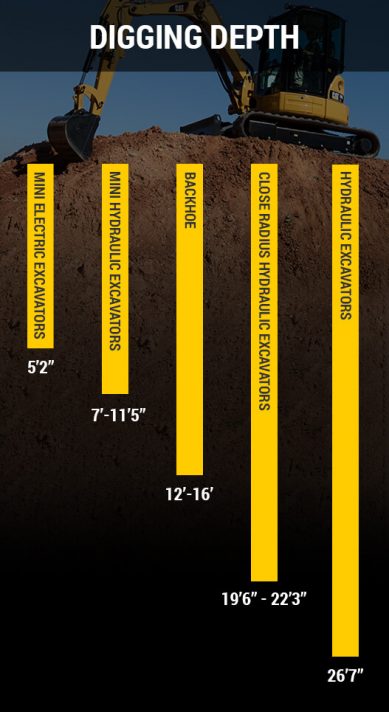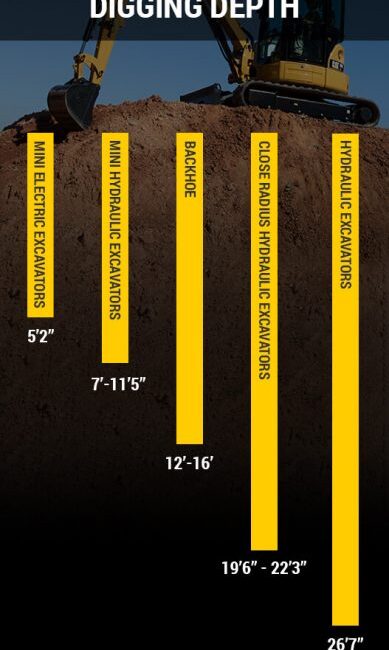Are you wondering about the maximum depth for digging with a skid steer? Well, you’ve come to the right place! Skid steers are versatile machines that can tackle a wide range of tasks, including digging. But before you start digging away, it’s important to know the limits of your skid steer.
When it comes to digging, skid steers have a maximum depth that they can safely reach. This depth is determined by factors such as the size and model of the skid steer, as well as the type of ground you’re working with. So let’s dive into the details and find out what you need to know!
So, what’s the maximum depth for digging with a skid steer? Stick around, and we’ll explore the factors that affect it, how to determine the safe digging depth, and tips for maximizing efficiency while digging with a skid steer. Get ready to unearth some valuable information!

What’s the Maximum Depth for Digging with a Skid Steer?
A skid steer is a versatile piece of heavy machinery commonly used in construction and landscaping projects. It is equipped with a bucket attachment that allows it to dig, lift, and move various materials. One important factor to consider when using a skid steer for digging is the maximum depth it can achieve. In this article, we will explore the factors that determine the maximum digging depth of a skid steer, safety considerations, and tips for optimizing performance.
Understanding the Factors
There are several factors that determine the maximum depth a skid steer can dig. One of the main factors is the size and type of bucket attachment used. Skid steers typically come with a range of bucket sizes, from small to large. The larger the bucket, the deeper the machine can dig. However, it is important to ensure that the skid steer has enough power to handle the larger bucket. Operating the machine beyond its capacity can lead to decreased performance, increased wear and tear, and potential safety hazards.
Another important factor is the hydraulic system of the skid steer. The hydraulic system powers the movement of the bucket attachment and determines its digging force. Higher hydraulic pressure and flow rates generally result in increased digging power. Skid steers with more advanced hydraulic systems can often achieve greater digging depths. It is important to refer to the specifications and recommendations provided by the skid steer manufacturer to ensure safe and optimal performance.
Ground conditions also play a significant role in the maximum digging depth. Soft and loose soil or sand allows for easier digging and greater depths. On the other hand, rocky or compacted soil may limit the depth that can be reached. It is important to assess the ground conditions before starting any digging operations to ensure the safety of the operator and prevent damage to the machine.
Safety Considerations
When operating a skid steer for digging purposes, it is crucial to prioritize safety. Here are a few important safety considerations to keep in mind:
- Always wear appropriate personal protective equipment (PPE), including a hard hat, safety glasses, gloves, and steel-toed boots.
- Familiarize yourself with the skid steer’s manual and safety guidelines provided by the manufacturer.
- Ensure the skid steer is on stable ground and set the parking brake before beginning any digging operations.
- Be aware of any underground utilities or obstacles that may be present in the digging area. Contact the local utility companies to mark the location of buried lines if needed.
- Never overload the skid steer beyond its rated capacity to prevent tipping or accidents.
- Maintain clear communication with any workers or colleagues in the vicinity to prevent accidents or injuries.
Tips for Optimizing Performance
To get the most out of your skid steer’s digging capabilities, consider the following tips:
- Choose the appropriate bucket size for the specific digging task. A larger bucket can increase the depth but may reduce maneuverability.
- Engage the auxiliary hydraulic system to increase the digging force. This allows for more efficient digging in tougher soil conditions.
- Ensure regular maintenance and inspections of the skid steer to keep it in optimal condition. Replace worn-out or damaged parts promptly.
- Practice proper digging techniques. Use a rocking motion to break up soil and avoid putting excessive strain on the machine.
- If digging in challenging soil conditions, consider using a specialized digging attachment, such as a toothed bucket or an auger.
Additional Considerations for Maximum Depth
When determining the maximum depth for digging with a skid steer, it is important to consider the specific model and specifications of the machine. Different skid steer models may have varying capabilities and limitations. Additionally, the weight distribution of the machine and the stability of the terrain can also impact the maximum depth achievable.
Choosing the Right Skid Steer for your Digging Needs
When selecting a skid steer for digging purposes, it is essential to consider the specific requirements of your project. Factors such as the size of the digging area, the type of soil or material to be excavated, and the expected depth are all important considerations.
Modern Technological Advancements in Skid Steer Digging
The skid steer industry continues to evolve with advancements in technology that enhance digging capabilities. Some modern skid steers are equipped with features like automatic leveling systems, 3D excavation control, and improved hydraulic systems, allowing for more precise and efficient digging operations.
Key Takeaways: What’s the Maximum Depth for Digging with a Skid Steer?
- A skid steer’s digging depth depends on its size and model.
- Smaller skid steers generally have a maximum digging depth of around 6 to 8 feet.
- Larger skid steers can dig to depths of 10 to 12 feet.
- Soil conditions and ground stability also affect the maximum depth a skid steer can dig.
- It’s important to consult the manufacturer’s specifications and guidelines for your specific skid steer to determine the maximum digging depth.
Frequently Asked Questions
In this section, we will address some common questions about the maximum depth for digging with a skid steer.
Can a skid steer dig to great depths?
Skid steers are versatile machines that are commonly used for various tasks, including digging. However, the maximum depth a skid steer can dig largely depends on its size and the type of attachments being used. Smaller skid steers generally have a lower digging depth compared to larger ones. Additionally, the type of ground and soil conditions can also affect the maximum depth that can be achieved.
It is important to consult the manufacturer’s guidelines and specifications for the specific skid steer model you are using. These guidelines will provide information on the maximum digging depth recommended for safe and efficient operation. It is crucial to follow these guidelines to avoid damaging the equipment or compromising safety.
What factors affect the maximum digging depth of a skid steer?
Several factors can impact the maximum digging depth of a skid steer. One significant factor is the size and weight of the skid steer. Generally, larger and heavier skid steers have more power and stability, allowing them to dig deeper. The type and condition of the soil also play a role. Hard, compacted soil may be more difficult to dig through compared to loose soil, affecting the maximum depth that can be achieved.
The type of attachment being used is also crucial. Different attachments have varying capabilities, and some may be specifically designed for deeper digging. It is essential to choose the appropriate attachment for the task at hand. Lastly, the skill and experience of the operator can influence the maximum digging depth. Skilled operators who are familiar with the equipment can optimize its performance and efficiency.
Is there a general maximum depth recommendation for skid steer digging?
It is difficult to provide a general maximum depth recommendation for skid steer digging because it varies depending on several factors. As mentioned earlier, the size and weight of the skid steer, the type of soil, and the attachment being used all contribute to the maximum depth that can be achieved. Additionally, different skid steer manufacturers may have different guidelines and specifications.
As a rule of thumb, it is best to consult the manufacturer’s guidelines and specifications for the specific skid steer model you are using. These guidelines will provide the most accurate and reliable information on the maximum digging depth recommended for safe and efficient operation.
Can the maximum digging depth be increased with modifications?
Modifications to a skid steer can potentially increase the maximum digging depth, but it is essential to exercise caution and consult with experts before making any modifications. Altering the design or configuration of a skid steer without proper knowledge and expertise can lead to safety risks and equipment damage.
It is recommended to work with skid steer manufacturers or authorized dealers to explore any available modifications that can increase the digging depth. These professionals have the knowledge and experience to determine if modifications are feasible and safe. They can also provide guidance on the specific modifications that may be required for your skid steer model to achieve greater digging depth.
Are there any limitations or risks associated with digging at maximum depth with a skid steer?
Digging at the maximum depth with a skid steer can come with certain limitations and risks. One limitation is the stability of the machine. As the digging depth increases, the center of gravity of the skid steer shifts, potentially compromising stability and increasing the risk of tipping over. It is crucial to ensure the skid steer is on stable ground and that the operator is trained to handle the equipment safely.
Another risk is damaging the equipment or the surrounding environment. Digging at maximum depth may put excessive stress on the skid steer, causing mechanical failures or breakdowns. The soil conditions and the presence of underground utilities or fragile structures must also be considered to avoid unintended damage.
Digging Depth Challenge: Bobcat Advantage for Augers
Summary
So, when it comes to digging with a skid steer, there are a few things to keep in mind. Firstly, the maximum digging depth will depend on the size and model of the skid steer you’re using. It’s important to consult the manufacturer’s specifications to find out the maximum depth for your particular machine.
Secondly, the type of soil you’re digging in will also affect the maximum depth. Soft, loose soil will be easier to dig into compared to compacted or rocky soil. So, if you’re planning on digging in tough conditions, you may need a more powerful skid steer or consider other digging methods.
Lastly, always remember to prioritize safety when digging with a skid steer. Be aware of any underground utilities or obstructions, and follow proper digging protocols to avoid accidents. With the right machine, soil conditions, and safety measures, you can tackle your digging projects effectively and efficiently.

